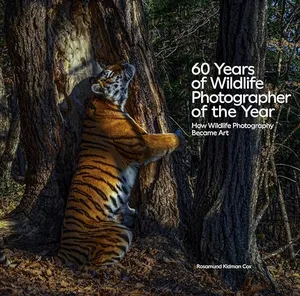Wildlife photography is a gripping blend of science and art. The science lesson comes from the subjects: Each image is a study of the natural world and all that can be learned from it. The art is in the otherworldly magic within the pictures—the majesty of a wolf’s face, the grace of swans on a lake, the bold colors of red-and-green macaws, the pose of a porcupine, the embrace of a tiger.
All of these breathtaking visuals and many more are featured in a new release from Smithsonian Books, 60 Years of Wildlife Photographer of the Year: How Wildlife Photography Became Art, by author and editor Rosamund Kidman Cox. In its pages are stunning looks at nature from the six decades of Wildlife Photographer of the Year, the prestigious annual international photography competition hosted by the Natural History Museum in London. The contest invites both professional and amateur photographers from all over the world to submit entries and culminates in an exhibition at the museum displaying some of the most powerful photos as chosen by an international jury. The recently announced top prize winner of this year's competition is an awe-inspiring image of a lake teeming with western toad tadpoles.
60 Years of Wildlife Photographer of the Year: How Wildlife Photography Became Art
Celebrating some of the most memorable and beautiful wildlife photographs from the past 60 years
The more than 200 images in the book display the splendor of nature. But in addition to the spectacle and beauty, some of the selections show the atrocities that animals and their environments can face from humans, such as a turtle stuck in a discarded net and a slaughtered black rhino with its horns sawed off.
From oceans to mountains, and woods to wetlands, the book serves as an ode to the animals and landscapes of planet Earth.
/https://tf-cmsv2-smithsonianmag-media.s3.amazonaws.com/filer_public/3c/b0/3cb0e7ec-a578-4259-860a-074b0d41a668/testing_the_depth_by_jean-louis_klein_and_marie-luce_hubert.png)
/https://tf-cmsv2-smithsonianmag-media.s3.amazonaws.com/filer_public/e9/8e/e98eb5f4-31f5-4875-8dab-42f3363cec35/first_encounter_-_anup_shah.png)
/https://tf-cmsv2-smithsonianmag-media.s3.amazonaws.com/filer_public/b3/90/b390b13a-1174-4a5a-9abe-19cb2b726cb2/pool_chaffinch_-_bence_mate.png)
/https://tf-cmsv2-smithsonianmag-media.s3.amazonaws.com/filer_public/2e/d1/2ed17b94-733d-43a6-bd21-df9557847ae2/the_embrace_-_sergey_gorshkov.png)
/https://tf-cmsv2-smithsonianmag-media.s3.amazonaws.com/filer_public/6c/a9/6ca9a82e-3796-4009-a646-cc55877752f0/the_pose_by_mogens_trolle.png)
/https://tf-cmsv2-smithsonianmag-media.s3.amazonaws.com/filer_public/8a/e9/8ae90422-a4b7-475b-b957-5df3e72e5091/universe_of_eggs_-_imre_potyo.png)
/https://tf-cmsv2-smithsonianmag-media.s3.amazonaws.com/filer_public/72/cc/72cc1bfd-cd7a-4352-8d3d-4f95583f27f7/head_to_head_-_stefano_unterthiner.png)
/https://tf-cmsv2-smithsonianmag-media.s3.amazonaws.com/filer_public/2c/83/2c834036-d928-42bc-96bc-2520e79228bc/heavenly_flamingos_by_junji_takasago.png)
/https://tf-cmsv2-smithsonianmag-media.s3.amazonaws.com/filer_public/f7/f5/f7f5f6c4-9716-4713-86e3-8ef7342821d7/the_big_buzz_-_karine_aigner.png)
/https://tf-cmsv2-smithsonianmag-media.s3.amazonaws.com/filer_public/75/ee/75eeba90-95d0-4426-82a4-50223c7596ac/pool_of_wonder_-_steven_david_johnson.png)
A Note to our Readers
Smithsonian magazine participates in affiliate link advertising programs. If you purchase an item through these links, we receive a commission.
:focal(668x439:669x440)/https://tf-cmsv2-smithsonianmag-media.s3.amazonaws.com/filer_public/d1/07/d1071285-2de7-452f-905d-e5ff2d94ff54/polar_frame_-_dmitry_kokh.png)
